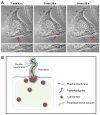Host cell invasion by Trypanosoma cruzi: a unique strategy that promotes persistence
- PMID: 22339763
- PMCID: PMC3319478
- DOI: 10.1111/j.1574-6976.2012.00333.x
Host cell invasion by Trypanosoma cruzi: a unique strategy that promotes persistence
Abstract
The intracellular protozoan parasite Trypanosoma cruzi is the causative agent of Chagas' disease, a serious disorder that affects millions of people in Latin America. Despite the development of lifelong immunity following infections, the immune system fails to completely clear the parasites, which persist for decades within host tissues. Cardiomyopathy is one of the most serious clinical manifestations of the disease, and a major cause of sudden death in endemic areas. Despite decades of study, there is still debate about the apparent preferential tropism of the parasites for cardiac muscle, and its role in the pathology of the disease. In this review, we discuss these issues in light of recent observations, which indicate that T. cruzi invades host cells by subverting a highly conserved cellular pathway for the repair of plasma membrane lesions. Plasma membrane injury and repair is particularly prevalent in muscle cells, suggesting that the mechanism used by the parasites for cell invasion may be a primary determinant of tissue tropism, intracellular persistence, and Chagas' disease pathology.
© 2012 Federation of European Microbiological Societies. Published by Blackwell Publishing Ltd. All rights reserved.
Figures




References
-
- Alves MJ, Colli W. Trypanosoma cruzi: adhesion to the host cell and intracellular survival. IUBMB Life. 2007;59:274–279. - PubMed
-
- Alves MJ, Mortara RA. A century of research: what have we learned about the interaction of Trypanosoma cruzi with host cells? Mem I Oswaldo Cruz. 2009;104 1:76–88. - PubMed
-
- Andrade LO, Andrews NW. The Trypanosoma cruzi-host-cell interplay: location, invasion, retention. Nat Rev Microbiol. 2005;3:819–823. - PubMed
-
- Andrews NW, Whitlow MB. Secretion by Trypanosoma cruzi of a hemolysin active at low pH. Mol Biochem Parasitol. 1989;33:249–256. - PubMed
Publication types
MeSH terms
Grants and funding
LinkOut - more resources
Full Text Sources
Medical

